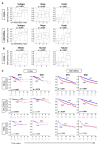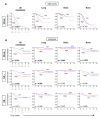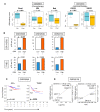G2M Cell Cycle Pathway Score as a Prognostic Biomarker of Metastasis in Estrogen Receptor (ER)-Positive Breast Cancer
- PMID: 32331421
- PMCID: PMC7215898
- DOI: 10.3390/ijms21082921
G2M Cell Cycle Pathway Score as a Prognostic Biomarker of Metastasis in Estrogen Receptor (ER)-Positive Breast Cancer
Abstract
The vast majority of breast cancer death is a result of metastasis. Thus, accurate identification of patients who are likely to have metastasis is expected to improve survival. The G2M checkpoint plays a critical role in cell cycle. We hypothesized that breast cancer tumors with high activity of G2M pathway genes are more aggressive and likely to metastasize. To test this, we used the single-sample gene set variation analysis method to calculate the score for the Hallmark G2M checkpoint pathway using gene expression data of a total of 4626 samples from 12 human breast cancer cohorts. As expected, a high G2M pathway score correlated with enriched tumor expression of other cell proliferation-related gene sets. The score was significantly associated with clinical aggressive features of tumors and patient survival in estrogen receptor (ER)-positive/human epidermal growth factor receptor 2 (HER2)-negative breast cancer. Interestingly, a high G2M score of metastasis tumors was also significantly associated with worse survival. In primary as well as metastasis tumors with high scores, the infiltration of both pro- and anti-cancerous immune cells increased. Tumor G2M score was also associated with treatment response to systemic chemotherapy in ER-positive/HER2-negative cancer, and was predictive of response to cyclin-dependent kinase inhibition therapy.
Keywords: G2M; biomarker; breast cancer; cell cycle; gene set; metastasis; pathway analysis; tumor gene expression.
Conflict of interest statement
The authors declare no conflict of interest. The funders had no role in the design of the study; in the collection, analyses, or interpretation of data; in the writing of the manuscript, or in the decision to publish the results.
Figures






References
-
- Chen G.L., Yang L., Rowe T.C., Halligan B.D., Tewey K.M., Liu L.F. Nonintercalative antitumor drugs interfere with the breakage-reunion reaction of mammalian DNA topoisomerase II. J. Biol. Chem. 1984;259:13560–13566. - PubMed
-
- Lock R.B., Ross W.E. Inhibition of p34cdc2 kinase activity by etoposide or irradiation as a mechanism of G2 arrest in Chinese hamster ovary cells. Cancer Res. 1990;50:3761–3766. - PubMed
MeSH terms
Substances
Grants and funding
LinkOut - more resources
Full Text Sources
Medical
Research Materials
Miscellaneous

